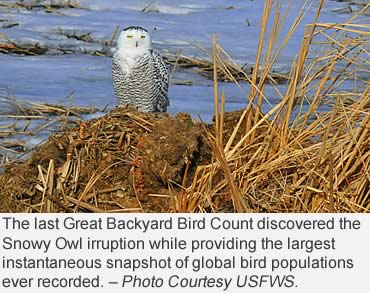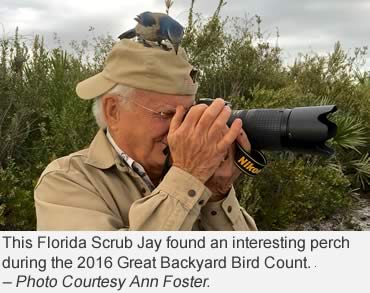When the first Christmas Bird Count (CBC) was held Christmas Day more than a century ago—118 years ago, in fact— its founder may not have known the occasion would become a holiday tradition appealing to bird watchers for generations.
That tradition has become, historically, the largest of ongoing citizen scientist projects.
American ornithologist and field guide author Frank Chapman created the Christmas Bird Count in 1900 as a way for the National Audubon Society to promote conservation by counting birds.
Today, thousands of volunteer bird counters of all ages throughout the United States, Canada and other countries in the Western Hemisphere, accumulate a vast amount of raw data about where birds are located during the event.
The CBC is a real census with objectives to track the health of bird populations on an enormous scale. It has been very successful effort, too.
Current director of the Christmas Bird Count Geoff LeBaron notes the count “is increasingly accepted by ornithologists and conservationists alike as the best, if not only, tool available to addressing the long-term trends in the early winter bird populations of North America.”
Small groups of volunteers venture forth to conduct a scientific, early winter census within 15-mile diameter circles, and complete the task within a 24-hour period on one calendar day between December 14 and January 5.
In 2017-18, more than 72,000 volunteers in 2,500 locations will count birds within their assigned circle. The data they collect will record every individual bird and bird species seen within a specified area.
 Ten or more volunteers, including a compiler who coordinates the process, count birds observed in each circle. The group separates into small parties and follows assigned routes, counting every bird they see. In most counting circles, some volunteers also watch feeders instead of following routes.
Ten or more volunteers, including a compiler who coordinates the process, count birds observed in each circle. The group separates into small parties and follows assigned routes, counting every bird they see. In most counting circles, some volunteers also watch feeders instead of following routes.
You can learn more about the CBC, how to volunteer, and what will be involved, by clicking on the geographic location near you.
The map for your area will identify the compiler and provide contact information, details on what to expect during the survey, as well as how to prepare for the day.
Many CBC compliers are associated with state Departments of Natural Resources or Conservation.
Missouri Department of Conservation state ornithologist Sarah Kendrick encourages experienced birders to join one of the 20 bird counts taking place in Missouri.
In Nebraska the Game and Parks Commission reports three state park areas across the state will be centers for the Christmas Bird Count, including Ponca State Park on Dec. 14, Indian Cave State Park on Dec. 16 and Lake Ogallala State Recreation Area on Dec. 30.
In Vermont, more than a dozen count areas and dates are available for birders, and can be found here.
 Don’t forget the Great Backyard Bird Count!
Don’t forget the Great Backyard Bird Count!
Unable to join the Christmas Bird Count? Don’t worry. You’ll have second chance to count feathered friends during the Great Backyard Bird Count conducted February 16 through 19, 2018.
Launched in 1998 by the Cornell Lab of Ornithology and the National Audubon Society, many volunteers find the Great Backyard Bird Count (GBBC) comfortably close to home.
It is, like the Christmas Bird Count, a citizen science project, but it is also the first online citizen-science project to collect wild bird data and display the results in real time.
Volunteers count birds for as little as 15 minutes a day, or for as long as they wish on one or more days during the four-day event, then report their sightings online to Birdcount.org.
If you’re new to bird-counting, it’s easy to become involved with the GBBC by creating an account and registering as a user at Birdcount.org.
During this past February, more than 160,000 volunteers submitted observations online, and as a result, they created the largest instantaneous snapshot of global bird populations ever recorded!
One of the interesting things discovered during the snapshot was a shift of bird populations, including the large irruption of Snowy Owls across the northeastern, mid-Atlantic and Great Lakes areas of the United States. Irruptions occur when temperature changes send Arctic owls southward.
You can read more about that irruption in the Critter Tale, When snowy owls appear in Michigan, biologists and researchers get busy here.
For a complete summary of what an estimated 214,000 participants, including many school children, saw when they identified 5,940 bird species during the 2017 Great Backyard Bird Count, click here.
You can use the website to explore real-time maps and charts and to learn more about birds, or take a peek at the annual GBBC photo contest image gallery. To get started with the Great Backyard Bird Count, click here.
– Resources: The National Audubon Society, the Cornell Lab of Ornithology, Missouri Department of Conservation, Nebraska Game and Parks Commission, Vermont Fish & Wildlife Department.